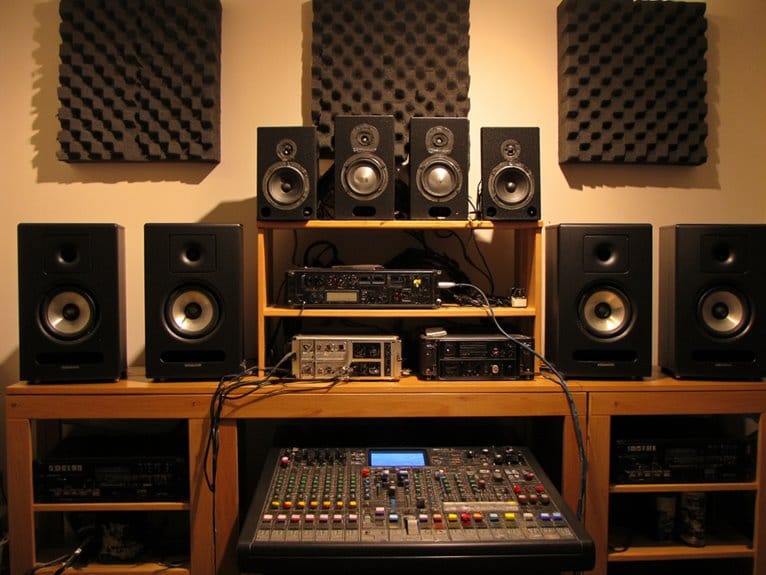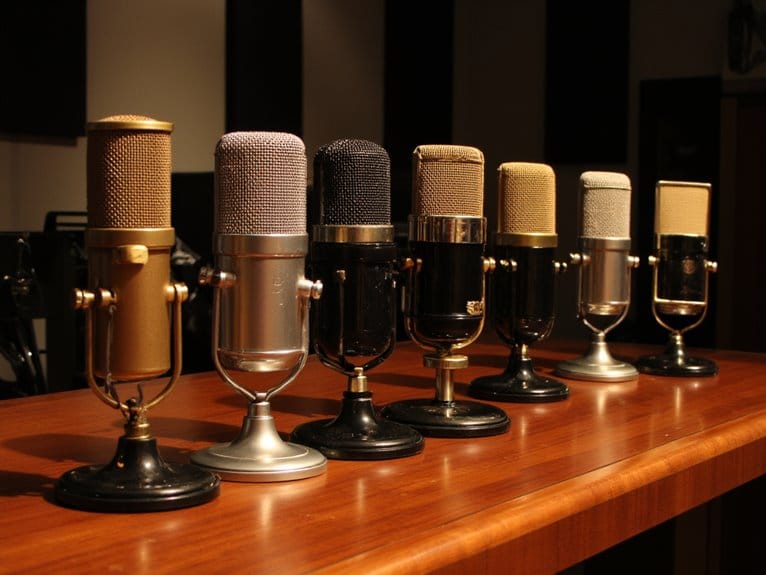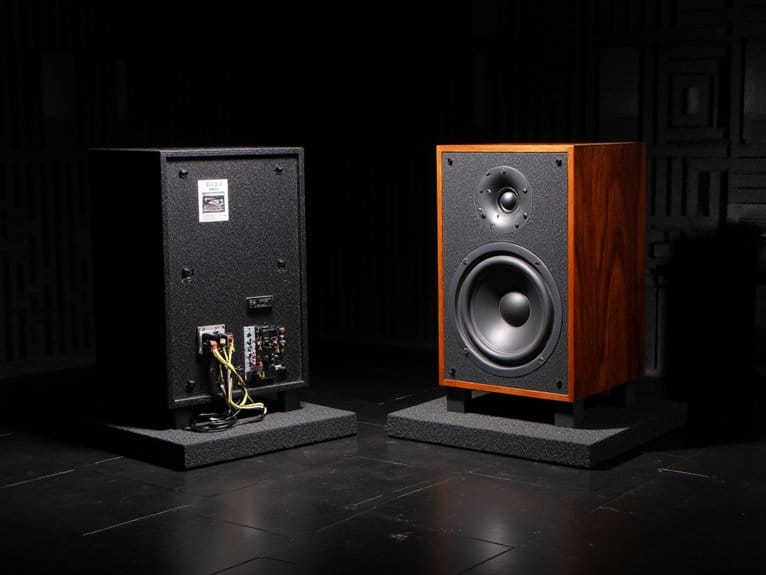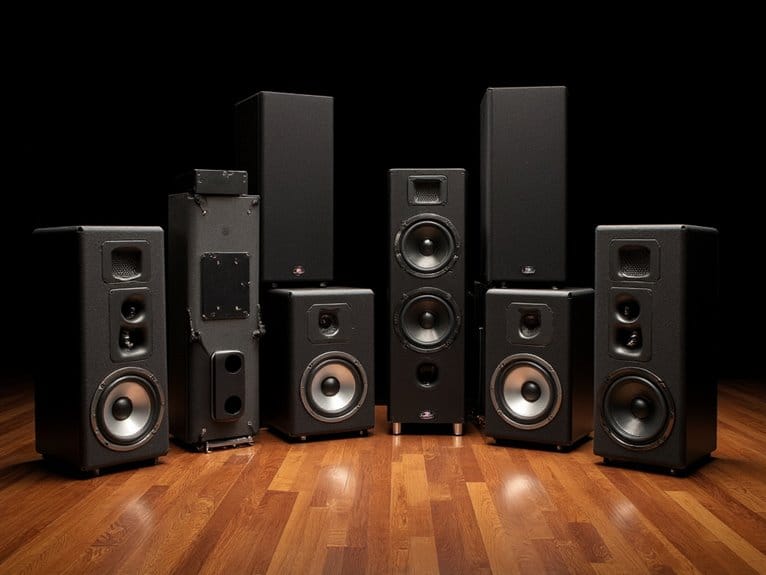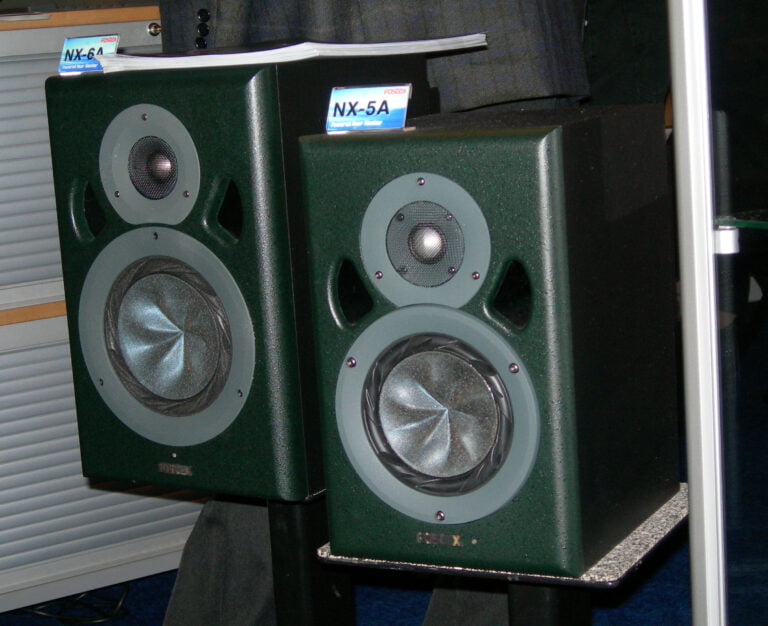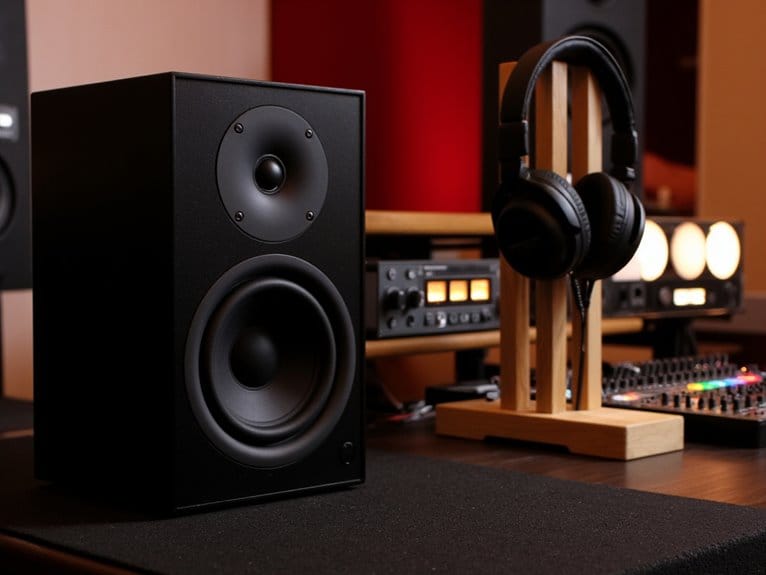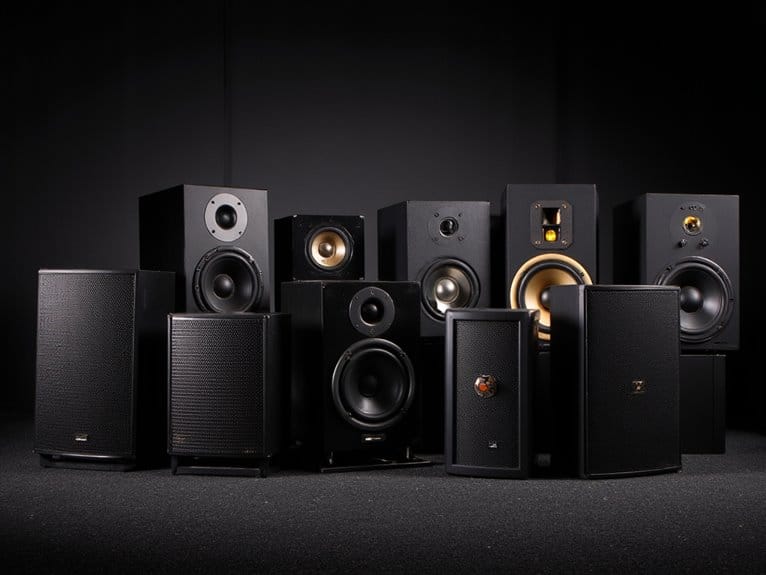10 Best Affordable Studio Monitors That Don’t Break the Bank
I’ve found that monitors like the PreSonus Eris 3.5BT, with Bluetooth connectivity and studio-quality sound, offer exceptional value under $200, while the JBL 305P MkII delivers professional flat frequency response that rivals pricier options. The Edifier MR4 and Yamaha HS3 provide compact designs perfect for small studios, featuring multiple input options including RCA, TRS, and aux connections. These monitors excel at mixing work but won’t satisfy bass-heavy productions or large rooms. Below, I’ll break down each model’s specific strengths.
We are supported by our audience. When you purchase through links on our site, we may earn an affiliate commission, at no extra cost for you. Learn more.
Notable Insights
- Affordable studio monitors deliver studio-quality sound with flat frequency response and professional engineering at accessible price points.
- Multiple connectivity options including RCA, AUX, TRS, and Bluetooth ensure compatibility with various audio interfaces and devices.
- Compact MDF cabinet designs with adjustable controls make them ideal for small home studios and limited workspace environments.
- Budget-friendly monitors excel at mixing and production work while maintaining transparent sound quality that rivals higher-end options.
- Limited power output and compact drivers restrict use to smaller rooms, lacking deep bass response for larger spaces.
PreSonus Eris 3.5BT Studio Monitors (3.5 Inch Powered Bookshelf Speakers)
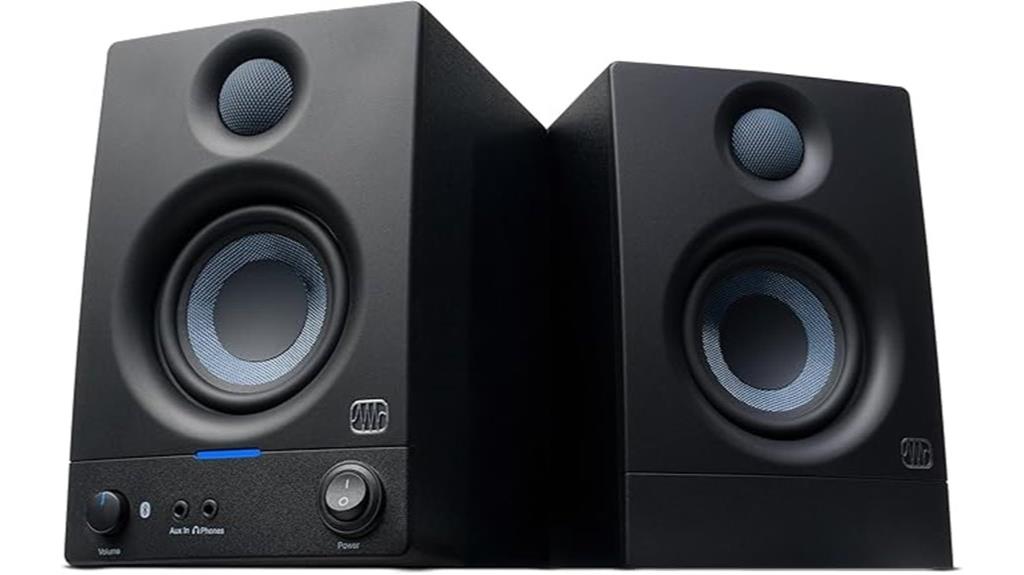
If you’re a bedroom producer, content creator, or gaming enthusiast who’s been cringing at the tinny sound from your laptop speakers, the PreSonus Eris 3.5BT Studio Monitors offer a compelling entry point into professional-grade audio monitoring. These compact 3.5-inch powered speakers deliver 50 watts of Class AB dual amplification, providing surprisingly clear audio without the distortion that typically plagues budget options. You’ll appreciate the woven-composite woofers that produce tight bass response, while silk-dome tweeters create an ultra-wide listening sweet spot perfect for desktop setups. The Bluetooth 5.0 connectivity, balanced TRS inputs, and front-panel aux input guarantee seamless integration with virtually any device in your creative arsenal.
Best For: Bedroom producers, content creators, and gaming enthusiasts seeking professional-grade audio monitoring with versatile connectivity options for desktop setups.
Pros:
- 50 watts of Class AB dual amplification delivers clear, distortion-free sound with tight bass response and ultra-wide listening sweet spot
- Multiple connectivity options including Bluetooth 5.0, balanced TRS inputs, RCA inputs, and front-panel aux input for seamless device integration
- Compact design with acoustic tuning controls and integrated headphone amplifier, perfect for small spaces like dorm rooms and home studios
Cons:
- Mediocre quality included cables that may require upgrading for optimal performance
- Cheaper cabinet build quality compared to higher-end studio monitors
- Limited power output may not be sufficient for larger rooms or professional studio environments
Ortizan C7 Dual-Mode 2.0 Studio Monitor Speakers (Pair, Black)
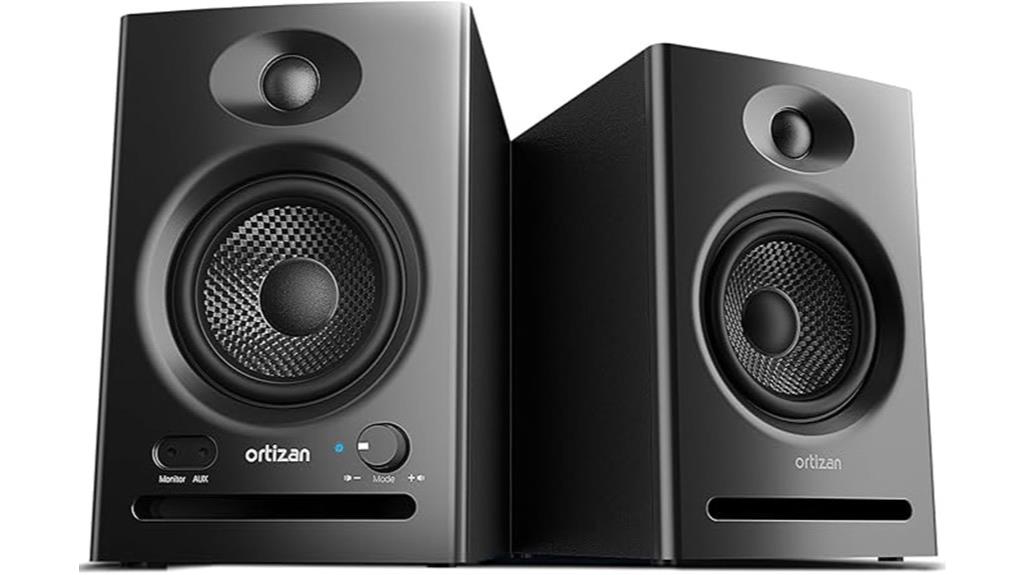
The Ortizan C7 Dual-Mode 2.0 Studio Monitors serve as versatility champions for budget-conscious creators who refuse to compromise between professional monitoring capabilities and wireless convenience. You’ll appreciate the built-in 24-bit DAC that minimizes signal loss, while the 3.5-inch carbon fiber drivers and silk dome tweeters deliver surprisingly flat response curves across frequencies. The Bluetooth 5.3 connectivity pairs within two seconds and maintains stable connections up to 18 meters, though I’ll admit the convenience sometimes tempts casual listening over critical monitoring work. Multiple inputs including RCA, AUX, and TRS balanced connections guarantee compatibility with your existing setup, making these compact 7.1-pound monitors exceptionally practical.
Best For: Budget-conscious musicians, podcasters, and content creators who need professional-quality studio monitors with the flexibility of both wired and wireless connectivity for production work and casual listening.
Pros:
- Built-in 24-bit DAC and flat response tuning deliver professional monitoring quality at an affordable price point
- Dual-mode connectivity with fast Bluetooth 5.3 pairing (2 seconds) and multiple wired inputs (RCA, AUX, TRS balanced)
- Compact, well-built design with convenient front-facing controls and excellent user ratings (4.6/5 stars)
Cons:
- Manual clarity issues and limited cable lengths noted in user feedback
- Bluetooth convenience may tempt casual listening over critical monitoring work
- Compact 3.5-inch drivers may lack the low-end extension of larger studio monitors
Edifier MR4 Powered Studio Monitor Speakers (Pair)
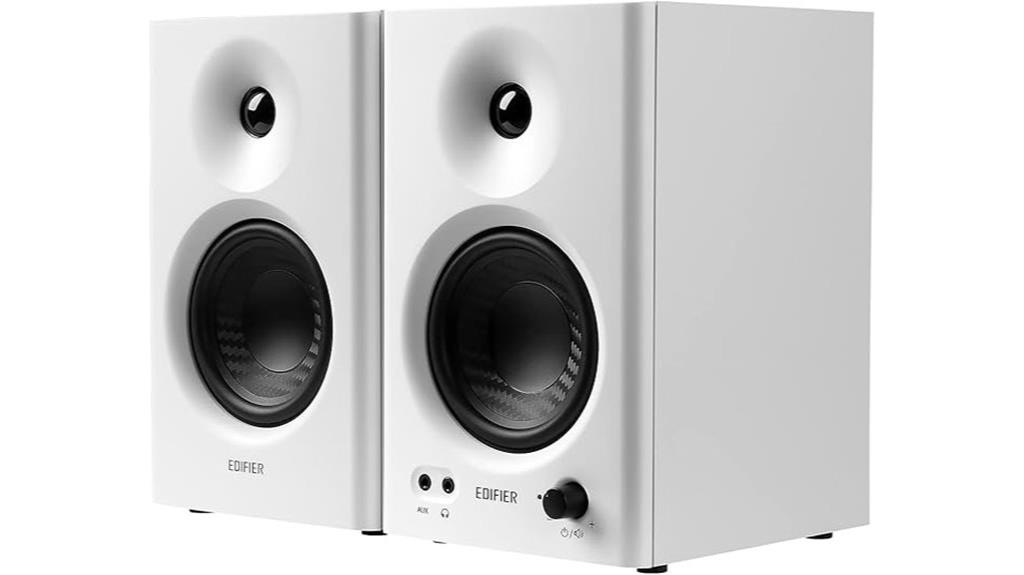
Music creators and casual listeners who want professional-grade monitoring without breaking the bank will find the Edifier MR4 Powered Studio Monitor Speakers perfectly suited for their needs, delivering true studio monitor performance through a dual-mode design that switches between precise production work and enhanced leisure listening. You’ll appreciate the 1-inch silk dome tweeters paired with 4-inch composite woofers, which produce clear, smooth sound through an MDF wooden structure that minimizes unwanted resonance. The connectivity options include 1/4-inch balanced TRS, unbalanced RCA, and AUX inputs, along with separate high- and low-frequency adjustment knobs that let you fine-tune your audio experience precisely to your preferences.
Best For: Music creators, artists, and casual listeners seeking professional-grade studio monitor speakers with dual-mode functionality for both precise audio production work and enhanced leisure listening at an affordable price point.
Pros:
- Dual-mode design allows switching between monitor mode for precise production work and music mode for enhanced bass and mids during casual listening
- Multiple connectivity options including 1/4-inch balanced TRS, unbalanced RCA, and AUX inputs with front headphone output for versatile device compatibility
- MDF wooden construction minimizes resonance while 1-inch silk dome tweeters and 4-inch composite woofers deliver clear, smooth sound with adjustable high and low frequency controls
Cons:
- High-end frequencies may lack some crispness and clarity compared to more expensive studio monitors
- Light distortion can occur in mid to high frequency ranges during certain audio playback
- Limited warranty coverage and signal-to-noise ratio of 85 dB may not meet requirements for professional studio environments
PreSonus Eris 3.5 Studio Monitors (Powered Active Speakers)
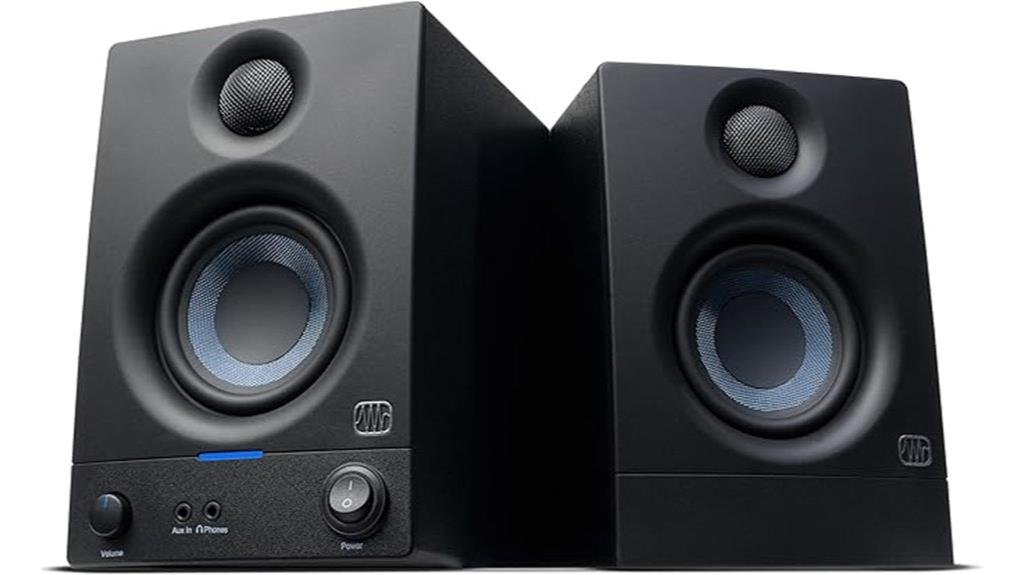
Compact powerhouses like the PreSonus Eris 3.5 Studio Monitors excel at delivering professional-grade audio in spaces where size matters most, making them ideal for bedroom producers, apartment dwellers, and anyone working within tight desktop constraints. These 50-watt Class AB monitors pack woven-composite woofers and 1-inch silk-dome tweeters into 6-inch-wide cabinets, delivering surprisingly tight bass response alongside crisp highs that won’t fatigue your ears during extended sessions. While they won’t fill larger rooms with sound, their adjustable frequency controls let you fine-tune output for your specific environment, and the front-panel aux input makes connecting phones effortless.
Best For: Bedroom producers, apartment dwellers, and desktop users who need professional-grade audio quality in compact spaces without disturbing neighbors or roommates.
Pros:
- Delivers studio-quality sound with tight bass and crisp highs in a compact 6-inch-wide design perfect for small spaces
- Features adjustable frequency controls and multiple input options including front-panel aux for easy device connectivity
- Offers excellent value with 50-watt Class AB power and professional drivers at an accessible price point
Cons:
- Limited power output makes them unsuitable for filling larger rooms or spaces
- Build quality may feel less robust compared to higher-end studio monitors
- Included cables are mediocre quality and may require upgrading for optimal performance
Mackie CR3.5 3.5-inch Powered Studio Monitors
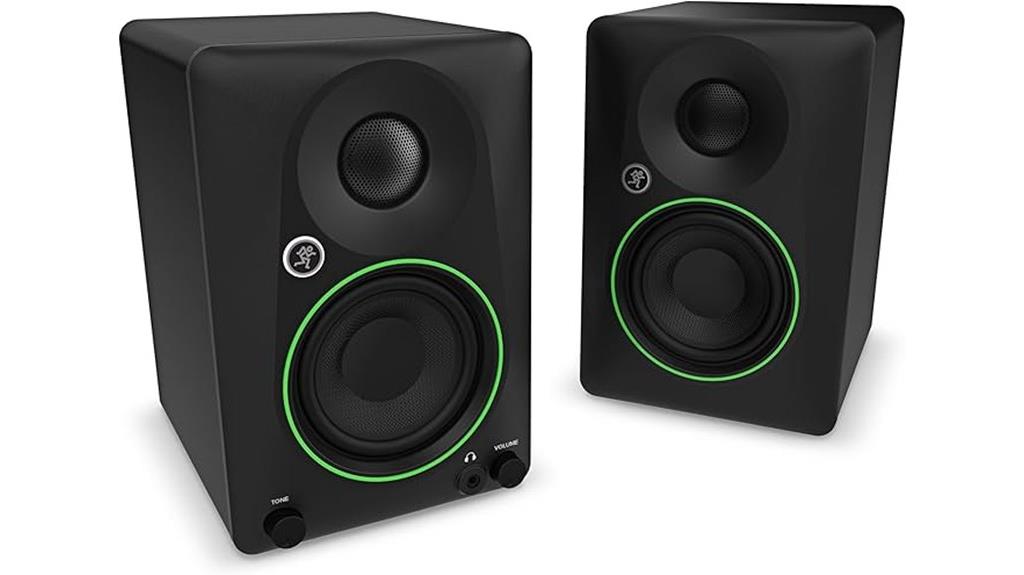
Three distinct tone modes make the Mackie CR3.5 monitors particularly valuable for creators who juggle multiple audio tasks throughout their day, from mixing tracks in studio reference mode to enjoying casual content or even hosting small gatherings. These compact 3.5-inch powered monitors deliver the transparent sound quality I’ve come to expect from professional studio equipment, while their multiple input options and switchable desktop-to-bookshelf positioning provide surprising versatility. With included RCA cables, foam isolation pads, and headphone output functionality, you’ll find everything needed for immediate setup, whether you’re editing videos or simply streaming content.
Best For: Content creators, home studio producers, and multimedia enthusiasts who need versatile monitors that can switch between professional audio work and casual listening throughout the day.
Pros:
- Three distinct tone modes (studio reference, casual listening, party mode) provide exceptional versatility for different audio tasks
- Transparent sound quality with flat response that rivals higher-end monitors like Yamaha NS 10’s despite the compact size
- Complete setup package with all necessary cables, foam isolation pads, and headphone output for immediate use
Cons:
- 3.5-inch drivers may lack the bass response and power needed for larger rooms or bass-heavy music production
- Limited to corded electric power source, restricting placement options compared to battery-powered alternatives
- Compact size may not provide the stereo imaging and soundstage width that larger studio monitors deliver
Ortizan C7 Dual-Mode Studio Monitor Speakers (Pair, Black)
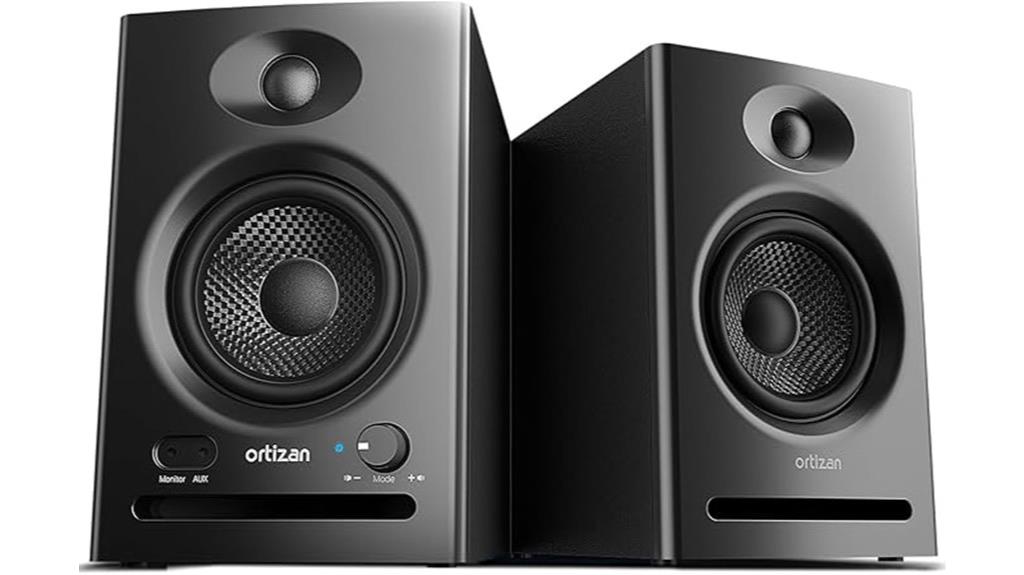
The Ortizan C7 Dual-Mode Studio Monitors emerge as a compelling choice for producers, content creators, and audio enthusiasts who demand professional-grade sound quality without the premium price tag that typically accompanies such performance. You’ll appreciate the thoughtful engineering behind these speakers, which feature a 24-bit DAC, 3.5-inch carbon fiber driver, and 0.75-inch silk dome tweeter that work together to deliver a remarkably flat frequency response. The dual-mode functionality lets you seamlessly switch between Bluetooth 5.3 wireless connectivity and traditional wired inputs like RCA and TRS, making these monitors versatile enough for both studio work and casual listening sessions.
Best For: Producers, content creators, and audio enthusiasts seeking professional-grade studio monitors with versatile connectivity options at an affordable price point.
Pros:
- Professional 24-bit DAC with flat frequency response and quality components (3.5-inch carbon fiber driver, silk dome tweeter)
- Versatile dual-mode connectivity including Bluetooth 5.3, RCA, AUX, and TRS balanced inputs
- Excellent value with high user satisfaction (4.6/5 stars) and performance that competes with more expensive monitors
Cons:
- Manual clarity issues reported by users
- Limited cable lengths included with the product
- Compact 3.5-inch driver may not provide sufficient bass response for larger rooms or bass-heavy production work
JBL Professional 305P MkII 5-Inch Powered Monitor Speakers (Sold as Pair)
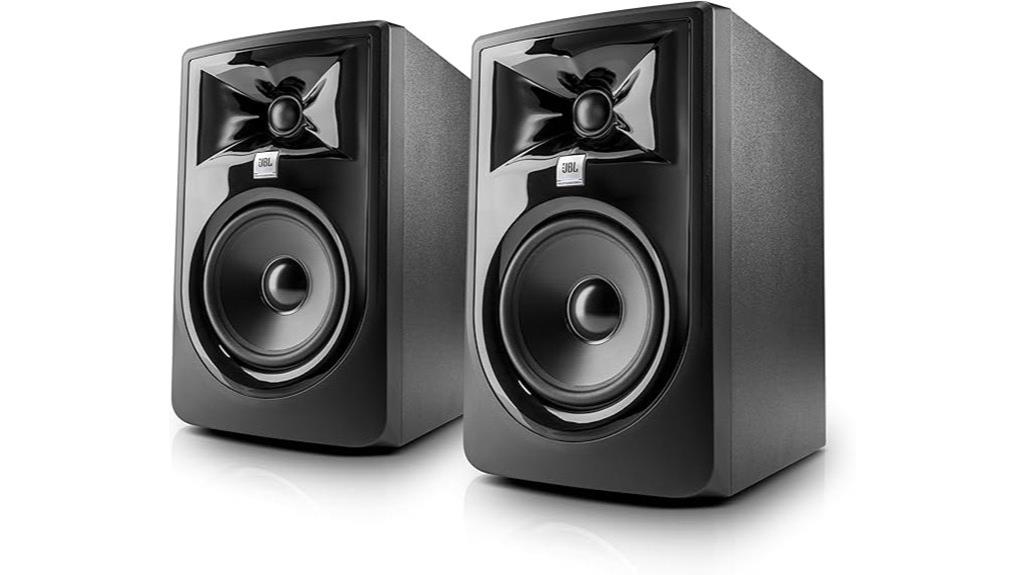
Near-field monitoring enthusiasts who demand professional-grade accuracy without breaking the bank will find their perfect match in the JBL Professional 305P MkII speakers, which deliver studio-quality sound reproduction through their meticulously engineered 5-inch two-way design. You’ll appreciate the patented Image Control Waveguide technology that creates precise imaging, while the updated transducers provide improved damping and crystal-clear highs that rival monitors costing considerably more. The dual 82-watt Class-D amplifiers deliver ample power for most studio environments, and I’ve found the balanced XLR and TRS inputs accommodate virtually any audio interface or mixing board you’re likely using in your home studio setup.
Best For: Near-field monitoring enthusiasts and home studio producers who need professional-grade accuracy for mixing, mastering, and music production without the premium price tag of high-end studio monitors.
Pros:
- Patented Image Control Waveguide technology delivers precise imaging and neutral frequency response with a wide sweet spot for accurate mix translation
- Dual 82-watt Class-D amplifiers provide ample power while updated transducers offer improved damping, deep bass, and crystal-clear highs that rival more expensive monitors
- Versatile connectivity with balanced XLR and 1/4″ TRS inputs, adjustable volume control, and high-frequency trim switch to accommodate various room acoustics and audio interfaces
Cons:
- Some users report durability concerns with control switches over extended use
- At 10.43 pounds each, the speakers may be too heavy for some desktop setups or require sturdy mounting solutions
- No built-in subwoofer means you’ll need to purchase the separate JBL LSR310S subwoofer for enhanced low-frequency extension in bass-heavy productions
M-Audio BX3 3.5 Studio Monitors, 120W (Pair, Black)
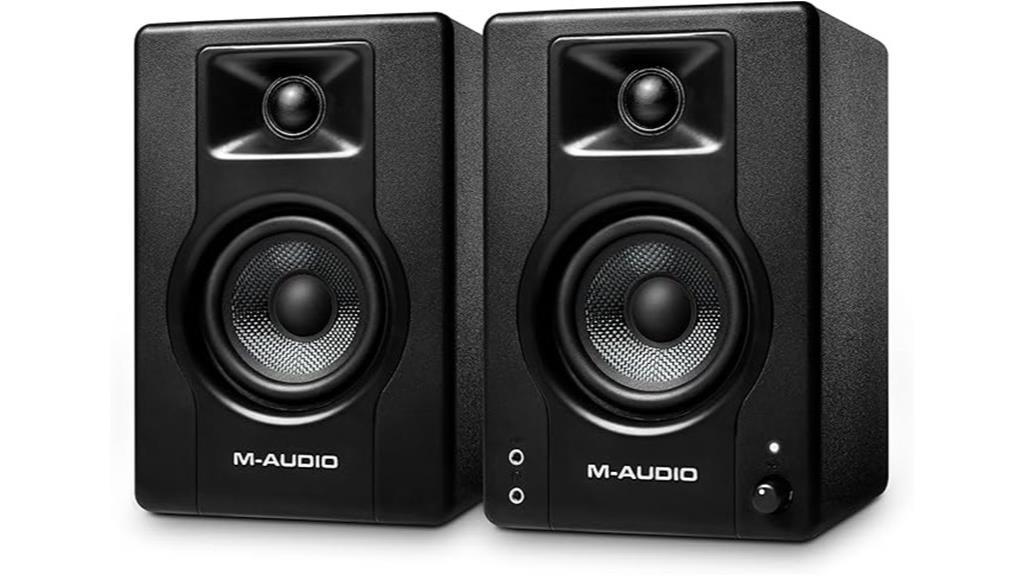
When you’re building your first home studio or upgrading from basic computer speakers, the M-Audio BX3 3.5 Studio Monitors deliver professional-grade sound quality that won’t devastate your budget, making them an ideal choice for content creators, podcasters, and bedroom producers who need accurate audio reproduction without the premium price tag. These compact 120W powered speakers feature 3.5″ Kevlar low-frequency drivers paired with 1″ silk dome tweeters, housed in acoustically-inert MDF cabinets with bass reflex design for surprisingly deep sound. The computer-optimized tweeter waveguide provides precise imaging, while rear-panel High and Low EQ controls let you customize the sound to your room’s acoustics, and versatile 1/4″, 1/8″, and RCA inputs guarantee compatibility with virtually any audio interface or device you’ll encounter.
Best For: Content creators, podcasters, and bedroom producers who need accurate studio-quality sound for recording, streaming, and multimedia production without breaking the budget.
Pros:
- Professional studio sound quality with 3.5″ Kevlar drivers and silk dome tweeters in acoustically-inert MDF cabinets
- Versatile connectivity options including 1/4″, 1/8″, and RCA inputs for compatibility with any audio interface or device
- Customizable sound with rear-panel High and Low EQ controls plus bass reflex design for enhanced low-end response
Cons:
- Compact 3.5″ drivers may lack the bass extension and overall volume of larger studio monitors
- Limited to 120W total power which may not be sufficient for larger rooms or professional studio environments
- Basic EQ controls offer less precision compared to dedicated studio monitor controllers or DSP-equipped alternatives
Yamaha HS3 Powered Studio Monitor in Black, Pair (HS3 B)
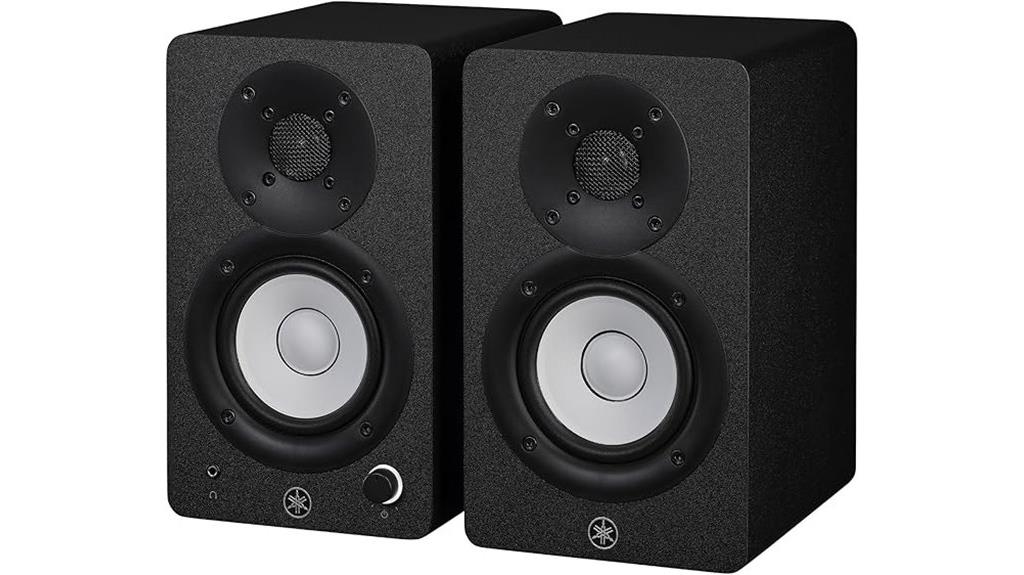
Compact home studios and cramped creative spaces have found their perfect audio companion in the Yamaha HS3 Powered Studio Monitor, a diminutive powerhouse that delivers professional-grade monitoring without demanding the real estate of larger alternatives. These 2-way bass-reflex speakers pack a 3.5″ cone woofer and 0.75″ dome tweeter into manageable 7D x 5.2W x 8.8H inch dimensions, delivering 26W of power with impressive 70 Hz – 22 kHz frequency response. The wood construction feels reassuringly solid, while XLR/TRS combo, RCA, and stereo mini inputs accommodate virtually any audio source you’ll throw at them. Sure, they won’t rattle your neighbor’s windows, but their flat response and minimal static earn consistent praise from creators who prioritize accuracy over earth-shaking volume.
Best For: Content creators and music producers working in small home studios or cramped spaces who need accurate audio monitoring without requiring high volume output or deep bass response.
Pros:
- Compact design with solid wood construction fits perfectly in limited desk space while maintaining professional build quality
- Multiple connectivity options (XLR/TRS combo, RCA, stereo mini) accommodate laptops, smartphones, tablets, and professional audio equipment
- Flat frequency response and minimal static provide accurate monitoring ideal for mixing and production work
Cons:
- Limited bass response may require a subwoofer for users who need deep low-end monitoring
- 26W power output restricts use to smaller rooms and won’t satisfy those needing high volume levels
- Frequency response starts at 70 Hz, missing the lowest bass frequencies important for some music genres
Factors to Consider When Choosing Affordable Studio Monitors
When I’m helping someone choose their first set of affordable studio monitors, I always emphasize that five critical factors will determine whether you’ll love or regret your purchase for years to come. These considerations—ranging from the physical dimensions and power specifications that’ll fit your workspace, to the connectivity options that’ll integrate with your existing gear—separate mediocre purchases from smart investments that enhance your audio production capabilities. I’ve seen too many producers rush into buying monitors without evaluating sound accuracy, build quality, and room compatibility, only to discover they’ve created more problems than solutions in their home studios.
Size and Power Output
The relationship between monitor size and power output forms the foundation of any successful studio setup, and I’ve learned that getting this balance right can make or break your mixing decisions. I typically recommend 4-inch or larger woofers for adequate bass response, though compact monitors under 6 inches work perfectly for desktop applications and smaller rooms. When it comes to power, I’ve found that 50 watts or more provides sufficient headroom for small monitors, preventing distortion during extended sessions. The key is matching your monitor’s capabilities to your room size, ensuring proper power-to-space ratios. I also consider enclosure design, whether bass reflex or sealed, since this greatly impacts how size and power translate into actual performance.
Connectivity and Input Options
Beyond size and power considerations, connectivity options determine how seamlessly your affordable studio monitors integrate with your existing equipment, and I’ve discovered that versatility in inputs can save you from costly adapter purchases down the road. Look for monitors offering multiple input options like RCA, TRS, and AUX connections, which accommodate everything from audio interfaces to smartphones without additional hardware. Bluetooth connectivity has become surprisingly common in budget models, delivering wireless convenience while maintaining signal quality that won’t embarrass your mixes. I particularly value monitors with dedicated headphone outputs, allowing private listening without constantly unplugging cables. Don’t overlook acoustic tuning controls and input sensitivity adjustments, which help optimize performance across different equipment levels and room acoustics.
Sound Accuracy and Response
Dialing in the perfect sound accuracy separates professional-grade monitoring from expensive desktop speakers, and I’ve learned that even budget models can deliver surprisingly honest frequency reproduction when you know which specifications matter most. I always prioritize a flat frequency response curve, which guarantees accurate reproduction across the entire audio spectrum without artificial coloration. A signal-to-noise ratio above 80 dB is non-negotiable for me, as it eliminates background interference that can muddy your mix decisions. I’ve found that woven-composite woofers provide tighter bass response, while silk-dome tweeters deliver clearer high frequencies that won’t fatigue your ears during long sessions. Look for acoustic tuning controls and ultra-wide sweet spots, which allow multiple listeners to experience consistent sound quality.
Build Quality and Materials
While sound accuracy gets most of the attention, I’ve discovered that build quality forms the foundation of every reliable studio monitor, and cutting corners on materials will compromise your listening experience faster than a poorly tuned frequency response. I always check for MDF construction first, since this material effectively minimizes cabinet resonance that muddles your mix. Wood, metal, or high-grade ABS plastics indicate manufacturers who understand that vibration control directly impacts sound clarity. I’ve learned to appreciate monitors with rubber feet or isolation pads, as these seemingly minor details reduce unwanted vibrations greatly. Heavier models typically signal sturdier construction, which translates to better longevity and stability during extended sessions, while well-engineered enclosures deliver tighter bass responses across all frequencies.
Room Size Compatibility
Matching your studio monitors to your room size determines whether you’ll hear accurate mixes or struggle with inadequate volume and distorted frequencies, and I’ve made this mistake enough times to know that size compatibility isn’t just about aesthetics. For compact spaces like bedrooms or dorm rooms, I recommend monitors with 25 watts per side, which provide clean sound without overwhelming smaller environments. Larger rooms demand higher power ratings—50 watts or above—to maintain clarity at necessary volumes without sacrificing fidelity. I always position monitors to create an equilateral triangle with my listening position, though this sweet spot varies based on room dimensions and monitor design. Don’t forget that sound-reflecting surfaces considerably impact your listening experience, particularly in spacious environments.
On a final note
I’ve tested countless studio monitors over the years, and while expensive models certainly have their merits, these affordable options deliver impressive performance that’ll satisfy most home studio needs. Whether you’re mixing your first track or upgrading from computer speakers, focusing on accurate frequency response, proper room positioning, and quality input connections will serve you better than chasing flashy features you don’t need.

